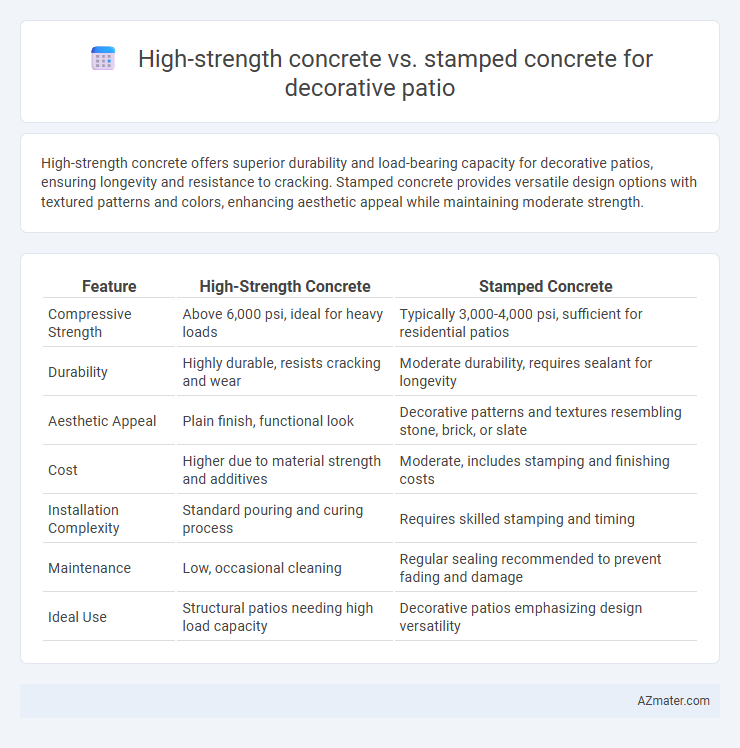High-strength concrete offers superior durability and load-bearing capacity for decorative patios, ensuring longevity and resistance to cracking. Stamped concrete provides versatile design options with textured patterns and colors, enhancing aesthetic appeal while maintaining moderate strength.
Table of Comparison
| Feature | High-Strength Concrete | Stamped Concrete |
|---|---|---|
| Compressive Strength | Above 6,000 psi, ideal for heavy loads | Typically 3,000-4,000 psi, sufficient for residential patios |
| Durability | Highly durable, resists cracking and wear | Moderate durability, requires sealant for longevity |
| Aesthetic Appeal | Plain finish, functional look | Decorative patterns and textures resembling stone, brick, or slate |
| Cost | Higher due to material strength and additives | Moderate, includes stamping and finishing costs |
| Installation Complexity | Standard pouring and curing process | Requires skilled stamping and timing |
| Maintenance | Low, occasional cleaning | Regular sealing recommended to prevent fading and damage |
| Ideal Use | Structural patios needing high load capacity | Decorative patios emphasizing design versatility |
Introduction to High-Strength and Stamped Concrete
High-strength concrete boasts compressive strengths typically above 6,000 psi, making it ideal for durable decorative patios that endure heavy traffic and environmental stress. Stamped concrete mimics natural stone, brick, or wood textures through imprinted patterns, offering aesthetic versatility alongside functional surface protection. Both materials serve distinct purposes: high-strength concrete ensures structural longevity while stamped concrete enhances visual appeal with customizable designs.
Core Material Differences
High-strength concrete, composed of a dense mixture with increased cement content and lower water-to-cement ratio, offers superior compressive strength and durability ideal for long-lasting decorative patios. In contrast, stamped concrete incorporates additives and color hardeners that enhance surface texture and aesthetic appeal while maintaining adequate strength for decorative finishes. The core material differences lie in the high-strength concrete's emphasis on structural integrity versus stamped concrete's focus on surface detail and visual customization.
Aesthetic Options and Customization
High-strength concrete offers a sleek, modern look with smooth finishes and limited color options, making it ideal for minimalist decorative patios requiring durability and subtle elegance. Stamped concrete provides extensive aesthetic versatility, mimicking natural stone, brick, or wood textures with customizable colors and intricate patterns, enhancing the visual appeal of patios with artisanal designs. The choice between high-strength and stamped concrete depends on desired customization levels and the balance between structural performance and artistic expression in outdoor living spaces.
Strength and Durability Comparison
High-strength concrete offers superior compressive strength typically above 6,000 psi, making it highly resistant to heavy loads and environmental wear, which ensures long-lasting performance in decorative patios. Stamped concrete, while visually versatile with textured patterns and colors, generally has standard concrete strength around 3,000 to 4,000 psi, making it less durable under extreme stress or freeze-thaw cycles without proper sealing. For patios requiring maximum durability and minimal maintenance, high-strength concrete outperforms stamped concrete in resisting cracking, abrasion, and weathering over time.
Installation Processes Explained
High-strength concrete offers a straightforward installation process involving mixing, pouring, and curing, ensuring durability for decorative patios that withstand heavy loads and weather conditions. Stamped concrete installation requires extra steps such as applying color hardeners, stamping patterns while the concrete is still wet, and sealing to enhance aesthetic appeal and mimic natural materials. Both methods demand skilled labor but differ in complexity, with stamped concrete installation requiring more detailed craftsmanship and longer curing times to achieve the desired decorative effect.
Maintenance Requirements Over Time
High-strength concrete for decorative patios demands minimal maintenance, resisting cracking and wear due to its dense composition and superior durability. Stamped concrete, while visually appealing with customizable patterns and textures, requires regular sealing every 2-3 years to protect against fading, moisture penetration, and surface damage. Over time, high-strength concrete offers a lower maintenance solution compared to stamped concrete, which can incur higher upkeep costs to preserve its aesthetic quality.
Cost Analysis: Upfront and Long-term
High-strength concrete for decorative patios involves higher upfront costs due to specialized mix designs and reinforced materials, but offers superior durability and reduced maintenance expenses over time, making it cost-effective in the long run. Stamped concrete presents a lower initial investment, with versatile aesthetic options that mimic more expensive materials; however, it may require frequent sealing and repairs, potentially increasing lifetime costs. Evaluating budget constraints against anticipated maintenance schedules and longevity helps determine the optimal choice for decorative patio projects.
Weather and Climate Performance
High-strength concrete offers superior durability and resistance to extreme weather conditions, making it ideal for patios exposed to freeze-thaw cycles, heavy rain, or intense heat. Stamped concrete provides aesthetic versatility but may require regular sealing to maintain its integrity against moisture penetration and UV damage in varying climates. Choosing high-strength concrete ensures long-term structural performance, while stamped concrete emphasizes decorative appeal with periodic maintenance to withstand environmental stress.
Slip Resistance and Safety Factors
High-strength concrete offers superior durability and higher compressive strength, making it a reliable choice for patios requiring robust structural integrity. Stamped concrete, while aesthetically versatile with various patterns and textures, can vary in slip resistance depending on the surface finish and sealants applied. For enhanced safety, high-strength concrete surfaces can be treated with anti-slip coatings, whereas stamped concrete requires careful selection of texture and sealant to reduce slip hazards, especially in wet conditions.
Best Applications: Which Patio Type to Choose?
High-strength concrete excels in structural durability and load-bearing capacity, making it ideal for patios subjected to heavy foot traffic or outdoor furniture with weight loads, offering long-lasting performance in various climates. Stamped concrete provides versatile aesthetic options, replicating natural stone, brick, or wood patterns, perfect for decorative patios where design and visual appeal are prioritized over maximum strength. Choosing between high-strength and stamped concrete depends on the patio's primary function--structural resilience suits functional outdoor living spaces, while stamped concrete enhances ornamental patios with intricate textured finishes.

Infographic: High-strength concrete vs Stamped concrete for Decorative patio
 azmater.com
azmater.com